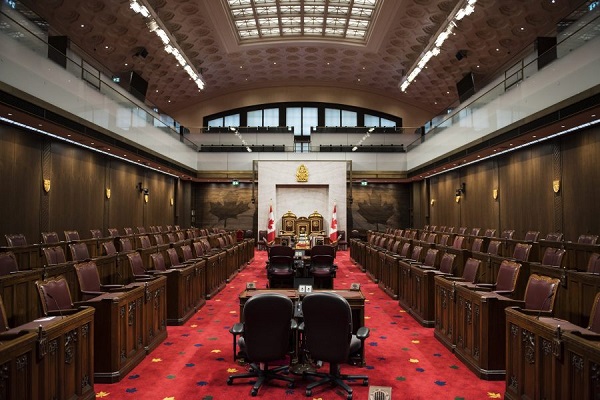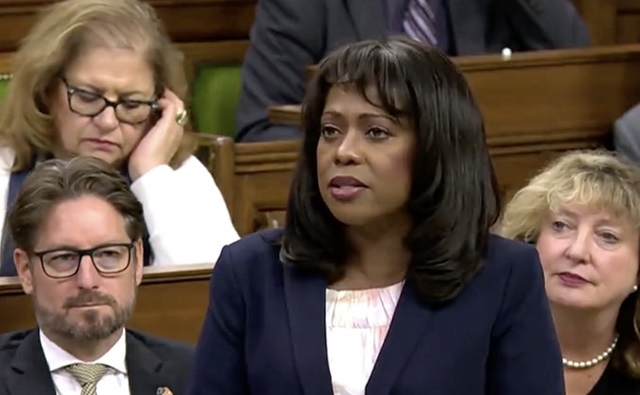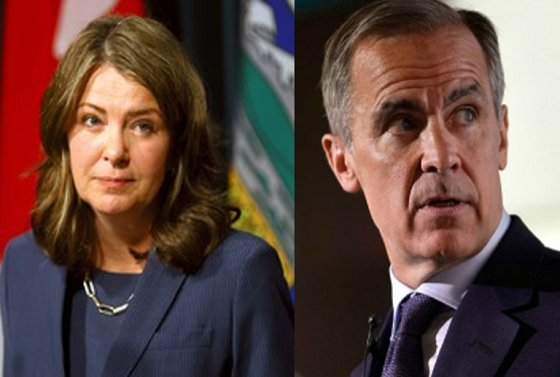Frontier Centre for Public Policy
Is the Senate in Violation of the 2006 Indian Residential Schools Settlement Agreement, and Hindering Reconciliation?

From the Frontier Centre for Public Policy
By Nina Green
Since it is abundantly clear there are no missing Indian residential school children, the ‘missing records’ by which they can be found are also imaginary, and the Senate Committee has been on a pointless wild goose chase
In July 2024 the Standing Senate Committee on Indigenous Peoples issued an Interim Report entitled ‘Missing Records, Missing Children’.
The problem with that title? There are no missing Indian residential school children.
Special Interlocutor Kimberly Murray told the Senate Committee on 21 March 2023 that there are no missing children, and in support of that one need only look to her own two interim reports, neither of which identifies a single Indian residential school child who went missing and whose parents didn’t know what happened to their child. In two years as Special Interlocutor, Kimberly Murray has not been able to name a single child who verifiably went missing from an Indian residential school.
Similarly, after two years of hearings, the Senate Committee itself was unable to name a single verifiably-missing Indian residential school child in its report.
Nor in fact has anyone in Canada to date been able to name a single verifiably-missing Indian residential school child.
Since it is abundantly clear there are no missing Indian residential school children, the ‘missing records’ by which they can be found are also imaginary, and the Senate Committee has been on a pointless wild goose chase which has cost Canadian provinces a very considerable amount of money since many of the witnesses called by the Committee have been provincial government employees whose departments have been forced to expend staff time and financial resources fruitlessly searching for records of missing Indian residential school children who are not missing.
Moreover by calling provincial coroners, medical examiners, and vital statistics department officials as witnesses, the Senate Committee has given the distinct impression that it is conducting a criminal investigation, and by focussing on Indian residential schools, the Committee has also given the distinct impression it has reconstituted itself as a new Truth and Reconciliation Commission (TRC), and is therefore in violation of the 2006 Indian Residential Schools Settlement Agreement.
What justification does the Senate Committee have for conducting this public inquiry into ‘Missing Records, Missing Children’, and threatening to compel the attendance of witnesses at its hearings?
The Committee cites the following Order of Reference passed by the full Senate as justification for its July 2024 report, and for the sweeping and far-reaching recommendations the report contains:
ORDER OF REFERENCE
Extract from the Journals of the Senate of Thursday, March 3, 2022:
The Honourable Senator Francis moved, seconded by the Honourable Senator Cordy:
That the Standing Senate Committee on Aboriginal Peoples be authorized to examine and report on the federal government’s constitutional, treaty, political and legal responsibilities to First Nations, Inuit and Métis peoples and any other subject concerning Indigenous Peoples; . . . .
It is glaringly obvious that the Order of Reference did not authorize the Committee to examine and report on missing Indian residential school children and missing records. The Senate is part of the federal government, the major party to the 2006 Indian Residential Schools Settlement Agreement under which Canadian taxpayers paid out billions of dollars to have all matters related to Indian residential schools settled once and for all – not re-opened by the Senate Committee on a whim. The Senate Committee has thus interpreted the Order of Reference as giving it an authority the full Senate did not explicitly mention, and in fact had no power to grant to the Committee.
During its proceedings over the past two years, the Senate Committee did not trouble itself to prove that there actually are missing Indian residential school children. Instead, the Committee operated on the basis that there are missing children even when Special Interlocutor Kimberly Murray told the Committee that ‘The children aren’t missing’.
Based on the false assumption that there are missing Indian residential children, the Committee proceeded to castigate those the Committee falsely claimed were ‘withholding’ records which would help to find them.
In doing so, the Committee ignored the fact that the only body which was ever actually entitled to records was the Truth and Reconciliation Commission (TRC).
Under the 2006 Indian Residential Schools Settlement Agreement, $60 million dollars was allocated to fund a Truth and Reconciliation Commission, and section 11 of the TRC’s Schedule N mandate stated that, subject to privacy interests:
Canada and the churches will provide all relevant documents in their possession or control to and for the use of the Truth and Reconciliation Commission.
It should be noted that under the TRC’s Schedule N mandate important limitations were put in place stipulating who was obligated to provide documents to the TRC, how long that obligation was to exist, and what was to be done in case of a dispute about the production of documents. The TRC’s Schedule N mandate provided that:
(1) only the federal government and the churches – i.e., not provincial governments or any other entity – were obliged to provide documents;
(2) the federal government and churches were only obliged to provide documents to the TRC during the TRC’s five-year mandate; and
(3) under section 2(l) of the TRC’s Schedule N mandate any ‘disputes over document production’ would be referred to an officially-designated body, the National Administration Committee (NAC) set up under section 4.11 of the 2006 Settlement Agreement.
The TRC concluded its work and issued a final report in 2015. That marked the end of any obligation on the part of the federal government and the churches to provide documents to the TRC, which ceased to exist and had no successor.
The Senate Committee has thus invented a problem where none existed.
That being the case – there was no problem until the Senate Committee invented one – exactly what is the problem the Senate Committee invented?
Again, one must refer back to the 2006 Settlement Agreement and the TRC’s Schedule N mandate. Section 2(a) of the Schedule N mandate states that, subject to privacy legislation, the TRC was:
authorized and required in the public interest to archive all such documents, materials, and transcripts or records of statements received, in a manner that will ensure their preservation and accessibility to the public.
To fulfil this part of its mandate, in 2013 the TRC entered into a trust deed with the University of Manitoba by which the University undertook to preserve the TRC records and make them available to the general public. That has not been done. The University of Manitoba has not made the records generated by the TRC itself in the course of its work and the records turned over to it by the federal government and the churches prior to 2015 available to the general public on its National Centre for Truth and Reconciliation (NCTR) Archives website. In particular, the University of Manitoba has not made available on its NCTR website the Sisters’ chronicles and Oblate codices which recorded daily life in the schools. Instead, the University has allowed its staff at the NCTR (which is not a legal entity and is not a successor to the TRC, but merely a building on the University of Manitoba campus staffed by University of Manitoba employees) to turn its millions of digitized records into a publicly-funded Indigenous genealogical service, as Head Archivist Raymond Frogner has explained on several occasions, and as Tanya Talaga documents in her new book, The Knowing.
Thus, if the Senate Committee had wanted to investigate an actual problem, it could have investigated why the University of Manitoba has not complied with its legal obligations under the 2013 trust deed and has not made the TRC records available to the general public as mandated by the 2006 Indian Residential Schools Settlement Agreement and the TRC’s Schedule N mandate, particularly the Sisters’ chronicles and Oblate codices which recorded daily life in the schools.
Instead of investigating that very real problem, the Senate Committee pursued a problem of its own invention by falsely claiming that records were being withheld from the ‘NCTR’ by Catholic church and provincial entities. This appears to be deliberate obfuscation because the Senate Committee must surely know that the NCTR is not a legal entity, and thus cannot legally receive documents. The actual recipient of documents sent to the ‘NCTR’ is the University of Manitoba, a fact which is never mentioned in the Senate report. Moreover the Senate report provided no evidence that any documents were actually being withheld, which of course it could not have done even had it tried since there is no legal obligation on the part of any entity to provide the University of Manitoba and the University’s NCTR staff with documents or records.
Ignoring the fact that it had invented a non-existent problem, the Senate Committee forged ahead, holding hearings and threatening to compel the attendance of witnesses. It is noteworthy that in so doing the Committee engaged in conduct which the TRC itself was forbidden to engage in under its Schedule N mandate, which states that ‘Pursuant to the Court-approved final settlement agreement and the class action judgments’, the TRC:
(b) shall not hold formal hearings, nor act as a public inquiry, nor conduct a formal legal process;
(c) shall not possess subpoena powers, and do not have powers to compel attendance or participation in any of its activities or events. Participation in all Commission events and activities is entirely voluntary;
Here is what Senator Scott Tannas had to say about holding hearings and hauling up witnesses in public on 21 March 2023 in an exchange with the University of Manitoba’s employee, Stephanie Scott:
Senator Tannas: Thank you for being here today. Ms. Scott, you mentioned that there are still organizations and people with data that has not been turned over to you. We all want to do things to help. Part of helping is listening and talking, but sometimes part of help that we can provide is to actually do something. Here in the Senate, we do have the ability to hold oversight hearings. We can compel people to come and testify before us. What would you think if you gave us the names and the contacts for organizations that aren’t providing data, and we’ll haul them up here in public and we’ll ask them why?
Ms. Scott: I would love for you to do that. We have been waiting a long time, and I think it’s absolutely crucial. When Tk’emlúps happened and the children began to speak from beyond, that’s when the world and the landscape changed for us. We used to have to do a lot of reaching out across the country, developing partnerships, still trying to acquire different records. We have worked closely — I think it’s time — the time is now, the time could be today that you call upon those people, and I would be more than willing to share that information with you. We have done a public media campaign. There are no secrets. Everything has been public and we all know what’s happened, many of us here at this table. If you are willing to do that, I respectfully would ask you to help.
Senator Tannas: I certainly would advocate for that. If you want to send the clerk, for future discussions, the name of let’s say the three most flagrant and obvious resistors, we could start maybe there and talk about it as a group. All senators would have to agree that’s a kind of meeting that we were going to have. To me, there is a time for action. As Senator Arnot mentioned, we’re not going to get anywhere until we get all the data. We won’t get to the full and complete truth, which is what all Canadians should want. It’s the only way we’re going to move forward. Thank you, that’s the only question I had.
‘Flagrant and obvious resistors’? It is unconscionable that Stephanie Scott, an employee of the University of Manitoba, would agree to provide (and did provide) the Senate Committee with a list of ‘flagrant and obvious resistors’ when she has to be aware that there is no legal obligation on the part of any entity to provide a single document to the University of Manitoba or its NCTR staff.
But even more importantly, it is unconscionable that the University of Manitoba and its NCTR employees continue to pretend that there are missing children, and continue to pretend that the University needs millions of records to identify these non-existent missing children.
Does the Senate Committee’s report further reconciliation? Obviously not. The report misleads Canadians, both Indigenous and non-Indigenous, in a way which is harmful to both by pretending that thousands of Indian residential school children are missing who are not missing, and that the provinces and the Catholic Church are withholding records that would help find them.
The Senate Committee should immediately withdraw its July 2024 interim report.
Nina Green is an independent researcher who lives in British Columbia.
Business
Is Carney Falling Into The Same Fiscal Traps As Trudeau?

From the Frontier Centre for Public Policy
By Jay Goldberg
Rosy projections, chronic deficits, and opaque budgeting. If nothing changes, Carney’s credibility could collapse under the same weight.
Carney promised a fresh start. His budget makes it look like we’re still stuck with the same old Trudeau playbook
It turns out the Trudeau government really did look at Canada’s economy through rose-coloured glasses. Is the Carney government falling into the same pattern?
New research from the Frontier Centre for Public Policy shows that federal budgets during the Trudeau years “consistently overestimated [Canada’s] fiscal health” when it came to forecasting the state of the nation’s economy and finances over the long term.
In his research, policy analyst Conrad Eder finds that, when looking specifically at projections of where the economy would be four years out, Trudeau-era budgets tended to have forecast errors of four per cent of nominal GDP, or an average of $94.4 billion.
Because budgets were so much more optimistic about long-term growth, they consistently projected that government revenue would grow at a much faster pace. The Trudeau government then made spending commitments, assuming the money would be there. And when the forecasts did not keep up, deficits simply grew.
As Eder writes, “these dramatic discrepancies illustrate how the Trudeau government’s longer-term projections consistently underestimated the persistence of fiscal challenges and overestimated its ability to improve the budgetary balance.”
Eder concludes that politics came into play and influenced how the Trudeau government framed its forecasts. Rather than focusing on the long-term health of Canada’s finances, the Trudeau government was focused on politics. But presenting overly optimistic forecasts has long-term consequences.
“When official projections consistently deviate from actual outcomes, they obscure the scope of deficits, inhibit effective fiscal planning, and mislead policymakers and the public,” Eder writes.
“This disconnect between projected and actual fiscal outcomes undermines the reliability of long-term planning tools and erodes public confidence in the government’s fiscal management.”
The public’s confidence in the Trudeau government’s fiscal management was so low, in fact, that by the end of 2024 the Liberals were polling in the high teens, behind the NDP.
The key to the Liberal Party’s electoral survival became twofold: the “elbows up” rhetoric in response to the Trump administration’s tariffs, and the choice of a new leader who seemed to have significant credibility and was disconnected from the fiscal blunders of the Trudeau years.
Mark Carney was recruited to run for the Liberal leadership as the antidote to Trudeau. His résumé as governor of the Bank of Canada during the Great Recession and his subsequent years leading the Bank of England seemed to offer Canadians the opposite of the fiscal inexperience of the Trudeau years.
These two factors together helped turn around the Liberals’ fortunes and secured the party a fourth straight mandate in April’s elections.
But now Carney has presented a budget of his own, and it too spills a lot of red ink.
This year’s deficit is projected to be a stunning $78.3 billion, and the federal deficit is expected to stay over $50 billion for at least the next four years.
The fiscal picture presented by Finance Minister François-Philippe Champagne was a bleak one.
What remains to be seen is whether the chronic politicking over long-term forecasts that plagued the Trudeau government will continue to be a feature of the Carney regime.
As bad as the deficit figures look now, one has to wonder, given Eder’s research, whether the state of Canada’s finances is even worse than Champagne’s budget lets on.
As Eder says, years of rose-coloured budgeting undermined public trust and misled both policymakers and voters. The question now is whether this approach to the federal budget continues under Carney at the helm.
Budget 2025 significantly revises the economic growth projections found in the 2024 fall economic statement for both 2025 and 2026. However, the forecasts for 2027, 2028 and 2029 were left largely unchanged.
If Eder is right, and the Liberals are overly optimistic when it comes to four-year forecasts, then the 2025 budget should worry Canadians. Why? Because the Carney government did not change the Trudeau government’s 2029 economic projections by even a fraction of a per cent.
In other words, despite the gloomy fiscal numbers found in Budget 2025, the Carney government may still be wearing the same rose-coloured budgeting glasses as the Trudeau government did, at least when it comes to long-range fiscal planning.
If the Carney government wants to have more credibility than the Trudeau government over the long term, it needs to be more transparent about how long-term economic projections are made and be clear about whether the Finance Department’s approach to forecasting has changed with the government. Otherwise, Carney’s fiscal credibility, despite his résumé, may meet the same fate as Trudeau’s.
Jay Goldberg is a fellow with the Frontier Centre for Public Policy.
Censorship Industrial Complex
A Democracy That Can’t Take A Joke Won’t Tolerate Dissent

From the Frontier Centre for Public Policy
By Collin May
Targeting comedians is a sign of political insecurity
A democracy that fears its comedians is a democracy in trouble. That truth landed hard when Graham Linehan, the Irish writer behind Father Ted and The IT Crowd, stepped off a plane at Heathrow on Sept. 1, 2025, and was met by five London Metropolitan Police officers ready to arrest him for three posts on X.
Returning to the UK from Arizona, he was taken into custody on the charge of “suspicion of inciting violence”, an allegation levelled with increasing ease in an age wary of offence. His actual “crime” amounted to three posts, the most contentious being a joke about trans-identified men in exclusively female spaces and a suggestion that violated women respond with a swift blow to a very sensitive part of the male’s not-yet-physically-transitioned anatomy.
The reaction to Linehan’s arrest, from J.K. Rowling to a wide array of commentators, was unqualified condemnation. Many wondered whether free speech had become a museum piece in the UK. Asked about the incident, British Prime Minister Keir Starmer defended his country’s reputation for free expression but declined to address the arrest itself.
Canada has faced its own pressures on comedic expression. In 2022, comedian Mike Ward saw a 12-year legal saga end when the Supreme Court of Canada ruled five-to-four that the Quebec Human Rights Commission had no jurisdiction to hear a complaint about comments Ward made regarding a disabled Quebec boy. The ruling confirmed that human rights bodies cannot police artistic expression when no discrimination in services or employment has occurred. In that case, comic licence survived narrowly.
These cases reveal a broader trend. Governments and institutions increasingly frame comedy as a risk rather than a social pressure valve. In an environment fixated on avoiding perceived harm, humour becomes an easy and symbolic target. Linehan’s arrest underscores the fragility of free speech, especially in comedic form, in countries that claim to value democratic openness.
Comedy has long occupied an unusual place in public life. One of its earliest literary appearances is in Homer’s Iliad. A common soldier, Thersites, is ugly, sharp-tongued and irreverent. He speaks with a freedom others will not risk, mocking Agamemnon and voicing the frustrations of rank-and-file soldiers. He represents the instinct to puncture pretension. In this sense, comedy and philosophy share a willingness to speak uncomfortable truths that power prefers to avoid.
Aristotle, in his Poetics, noted that tragedy imitates noble actions and depicts people who are to be taken seriously. Comedy, by contrast, imitates those who appear inferior. Yet this lowly status is precisely what gives comedy its political usefulness. It allows performers to say what respectable voices cannot, revealing hypocrisies that formal discourse leaves untouched.
In the Iliad, Thersites does not escape punishment. Odysseus, striving to restore order, strikes him with Agamemnon’s staff, and the soldiers laugh as Thersites is silenced. The scene captures a familiar dynamic. Comedy can expose authority’s flaws, but authority often responds by asserting its dominance. The details shift across history, but the pattern endures.
Modern democracies are showing similar impatience. Comedy provides a way to question conventions without inviting formal conflict. When governments treat jokes as misconduct, they are not protecting the public from harm. They are signalling discomfort with scrutiny. Confident systems do not fear irreverence; insecure ones do.
The growing targeting of comedians matters because it reflects a shift toward institutions that view dissent, even in comedic form, as a liability. Such an approach narrows the space for open dialogue and misunderstands comedy’s role in democratic life. A society confident in itself tolerates mockery because it trusts its citizens to distinguish humour from harm.
In October, the British Crown Prosecution Service announced it would not pursue charges against Linehan. The London Metropolitan Police Service also said it would stop recording “non-crime hate incidents”, a controversial category used to document allegations of hateful behaviour even when no law has been broken. These reversals are welcome, but they do not erase the deeper unease that allowed the arrest to happen.
Comedy survives, but its environment is shifting. In an era where leaders are quick to adopt moral language while avoiding meaningful accountability, humour becomes more necessary, not less. It remains one of the few public tools capable of exposing the distance between political rhetoric and reality.
The danger is that in places where Agamemnon’s folly, leadership driven by pride and insecurity, takes root, those who speak uncomfortable truths may find themselves facing not symbolic correction but formal sanctions. A democracy that begins by targeting its jesters rarely stops there.
Collin May is a Senior Fellow with the Frontier Centre for Public Policy, a lawyer, and Adjunct Lecturer in Community Health Sciences at the University of Calgary, with degrees in law (Dalhousie University), a Masters in Theological Studies (Harvard) and a Diplome d’etudes approfondies (Ecole des hautes etudes, Paris).
-

 Censorship Industrial Complex2 days ago
Censorship Industrial Complex2 days agoConservative MP Leslyn Lewis slams Liberal plan targeting religious exemption in hate speech bil
-

 Business2 days ago
Business2 days agoCanada’s climate agenda hit business hard but barely cut emissions
-

 Health2 days ago
Health2 days agoNews RFK Jr.’s vaccine committee to vote on ending Hepatitis B shot recommendation for newborns
-

 International1 day ago
International1 day agoFBI may have finally nabbed the Jan. 6 pipe bomber
-

 Bruce Dowbiggin1 day ago
Bruce Dowbiggin1 day agoIntegration Or Indignation: Whose Strategy Worked Best Against Trump?
-

 Health2 days ago
Health2 days ago23,000+ Canadians died waiting for health care in one year as Liberals pushed euthanasia
-

 MAiD1 day ago
MAiD1 day ago101-year-old woman chooses assisted suicide — press treats her death as a social good
-

 Business1 day ago
Business1 day agoCarney’s Toronto cabinet meetings cost $530,000






